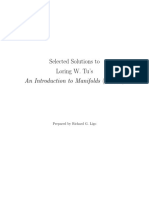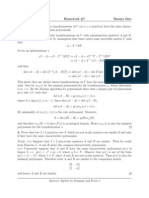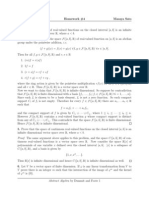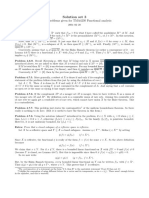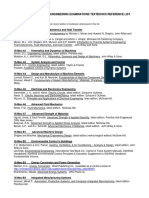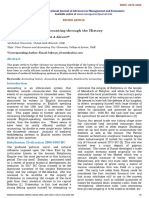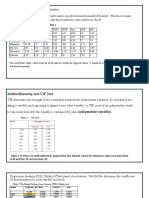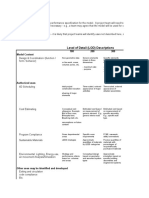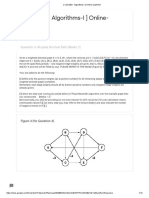Homework #9, Sec 13.2 and Sec 13.3
Homework #9, Sec 13.2 and Sec 13.3
Uploaded by
Masaya SatoCopyright:
Available Formats
Homework #9, Sec 13.2 and Sec 13.3
Homework #9, Sec 13.2 and Sec 13.3
Uploaded by
Masaya SatoOriginal Description:
Copyright
Available Formats
Share this document
Did you find this document useful?
Is this content inappropriate?
Copyright:
Available Formats
Homework #9, Sec 13.2 and Sec 13.3
Homework #9, Sec 13.2 and Sec 13.3
Uploaded by
Masaya SatoCopyright:
Available Formats
Section 13.2 and 13.3.
Homework #9 Masaya Sato
Sec 13.2
3. Determine the minimal polynomial over Q for the element 1 + i.
Solution: Observe that 1 + i is a root of the quadratic polynomial x2 + 2x + 2. By the
Rational Root Theorem, the polynomial is irreducible over Q. So x2 + 2x + 2 is the minimal
polynomial.
√ √ √
4. Determine the degree over Q of 2 + 3 and of 1 + 3 2 + 3 4.
√ √
Solution: First consider the extension Q(2 + 3) of Q. Observe that 2 + 3 is a root of
the polynomial
x2 − 4x + 1,
and x2 − 4x + 1 is irreducible over Q by the Rational Root Theorem √ or Gauss’s Lemma. So
the polynomial is the minimal polynomial
√ √ and therefore [Q(2 + 3) : Q]√= 2. √ √
3 3 3 3 3
Next consider√ the extension Q(1 + √ 2 + 4)
√ of Q. Observe that Q(1 + 2 + 4) = Q( 4)
3 3 3 3
since 1 and 2 are generated by 4. And 4 is a root of the polynomial x − 4, which is
irreducible over Q by Rational Root Theorem or Gauss’s Lemma. So
√
3
√
3
√
3
[Q(1 + 2 + 4) : Q] = [Q( 4) : Q] = 3.
5. Let F = Q(i). Prove that x3 − 2 and x3 − 3 are irreducible over F .
Proof. First suppose by contradiction that x3 − 2 is reducible over F . Then at least one root
is in F since x3 − 2 decomposes into two polynomials, i.e.,
x3 − 2 = (x − α)q(x),
√
1 3
where α ∈ F and q(x) is some monic quadratic polynomial. Now let ζ = 2
+ 2
i. Then the
roots of x3 − 2 are √ √ √
3 3 3
2, 2ζ, and 2ζ,
where ζ denotes the complex conjugate of ζ. Observe that every element in F is of the form
a + bi,
a and b are elements in Q. However none of the roots is of the form. Therefore x3 − 2 is
irreducible over F . √ √ √
Similarly, if x3 − 3 is reducible over F , then the roots are 3 3, 3 3ζ, and 3 3ζ. However, none
of the roots is of the form a + bi, where a and b are in Q. Therefore x3 − 3 is irreducible over
F.
p √
10. Determine the degree of the extension Q( 3 + 2 2) over Q.
p √
Solution: Observe first that 3 + 2 2 is a root of the polynomial p(x) = x4 − 6x2 + 1. p(x)
is irreducible over Q by Rational
p Root Theorem or Gauss 0 sLemma. So p(x) is the minimal
√
polynomial and therefore [Q( 3 + 2 2) : Q] = 4.
Abstract Algebra by Dummit and Foote 1
Section 13.2 and 13.3. Homework #9 Masaya Sato
12. Suppose the degree of the extension K/F is a prime p. Show that any subfield E of K
containing F is either K or F .
Proof. By assumption the degree [K : F ] = p, where p is some prime. Since E is a subfield
of K containing F , i.e. F ≤ E ≤ K,
p = [K : F ] = [K : E][E : F ].
Then consider the following two cases.
Case 1: [K : E] = 1 and [E : F ] = p. Then E = K.
Case 2: [K : E] = p and [E : F ] = 1. Then E = F .
√
13. Suppose F = Q(α1 , α2 , . . . , αn ) where αi2 ∈ Q for i = 1, 2, . . . , n. Prove that 3
2∈
/ F.
Proof. Observe first that the degree√of extension F/Q is 2k for some √ positive integer
√ k.
3 3 3
Then suppose by contradiction that 2 ∈ F . Any field containing 2 includes Q( 2) as a
subfield. Therefore
√3
√
3
√3
[F : Q] = [F : Q( 2)][Q( 2) : Q] = 3[F : Q( 2)],
√
and thus [F : Q] is divisible by 3. This contradicts that [F : Q] = 2k . Hence 3 2 ∈
/ F.
14. Prove that if [F (α) : F ] is odd then F (α) = F (α2 ).
Proof. Since [F (α) : F ] is finite, α is algebraic over F . This implies that α2 = αα is algebraic
over F . So the simple extension [F (α2 ) : F ] is finite. Therefore
[F (α) : F ] = [F (α) : F (α2 )][F (α2 ) : F ] ⇒ 2k + 1 = [F (α) : F (α2 )][F (α2 ) : F ]
for some positive integer k. Observe that [F (α) : F (α2 )] ≤ 2. If [F (α) : F (α2 )] = 2,
then this contradicts that [F (α) : F ] = 2k + 1. Therefore [F (α) : F (α2 )] = 1 and thus
F (α) = F (α2 ).
16. Let K/F be an algebraic extension and let R be a ring contained in K and containing
F . Show that R is a subfield of K containing F .
Proof. For every nonzero α ∈ R α is algebraic over F since α ∈ K. So α is a root of some
irreducible polynomial p(x) of the form
p(x) = an xn + · · · + a1 x + a0 ,
where a0 , a1 , . . . , an ∈ F . If a0 = 0, then p(x) = x since otherwise p(x) would be reducible.
Moreover 0 = p(α) = α. So suppose that a0 6= 0. Then
0 = p(α) = an αn + · · · + a1 α,
and thus
α−1 = −(a0 )−1 (an αn−1 + · · · + a1 ) ∈ R
is a multiplicative inverse of α. Therefore R is a field.
Abstract Algebra by Dummit and Foote 2
Section 13.2 and 13.3. Homework #9 Masaya Sato
19. Let K be an extension of F of degree n.
(a) For any α ∈ K prove that α acting by left multiplication on K is an F -linear transfor-
mation of K.
(b) Prove that K is isomorphic to a subfield of the ring of n × n matrices over F , so the ring
of n × n matrices over F contains an isomorphic copy of every extension of F of degree
≤ n.
Proof. (a) Let fα : K → K be a map defined by
fα (x) = αx.
Then for all x and y in K
fα (x + y) = α(x + y) = αx + αy = fα (x) + fα (y),
and for every λ ∈ F
fα (λx) = α(λx) = (αλ)x = (λα)x = λ(αx) = λfα (x).
Therefore the map fλ , which corresponds to left multiplication on K by α, is an F -linear
transformation on K.
(b) For α and β in K assume that fα (x) = fβ (x) for every x ∈ K. Then
fα (x) = fβ (x) ⇒ αx = βx
and thus α = β by setting x = 1. So the action of an element in K by left multiplication is
an injective F -linear transformation. Moreover for all α and β in K and x ∈ K
fα+β (x) = (α + β)x = αx + βx = fα (x) + fβ (x), and
fαβ (x) = (αβ)x = α(βx) = fα (fβ (x)) = (fα fβ )(x).
Therefore K is isomorphic to the ring of n × n matrices over F . Furthermore the ring of
n × n matrices contains an isomorphic copy of every extension of F of degree less than or
equal to n.
Sec 13.3 √ √
4. Prove that Q( 2) and Q( 3) are not isomorphic.
√ √
Proof. Suppose by contradiction that there exists an isomorphism ϕ : Q( 2) → Q( 3).
Then observe that ϕ(1) = 1 and
√ √
2 = 2ϕ(1) = ϕ(2) = ϕ(( 2)2 ) = (ϕ( 2))2 .
√ √ √ √
So ϕ( 2) is either 2 or − 2. Since every element α ∈ Q( 3) is of the form
√
α = a + b 3,
Abstract Algebra by Dummit and Foote 3
Section 13.2 and 13.3. Homework #9 Masaya Sato
there are some a and b in Q such that
√ √
2 = a + b 3.
Then
√ √ √
2 = a + b 3 ⇒ 4 = a2 + 3b2 + 2ab 3
√ 4 − a2 − 3b2
⇒ 3= .
2ab
√ √ √
However this contradicts that 3 is irrational. Therefore Q( 2) and Q( 3) are not isomor-
phic.
√ √
5. Determine the automorphisms of the extension Q( 4 2)/Q( 2) explicitly.
√ √ √
Solution: Observe first that√4 2 is a root of an irreducible polynomial x2 − 2 ∈ Q( 2)[x].
So the automorphisms of Q( 4 2) are the identity map id and ϕ that maps
√
4
√4
√4
√
4
2 7→ 2 or 2 7→ − 2.
√ √
So ϕ(a + b 4 2) = a − b 4 2.
Abstract Algebra by Dummit and Foote 4
You might also like
- Vakil Solutions PDFDocument69 pagesVakil Solutions PDFNew userNo ratings yet
- Sol. Stein Cap 6 PDFDocument9 pagesSol. Stein Cap 6 PDFAline Melo100% (1)
- Solutions - An Introduction To ManifoldsDocument79 pagesSolutions - An Introduction To ManifoldsNoel Banton100% (11)
- Lang Chapter 5Document21 pagesLang Chapter 5Fakhir Shaheen100% (2)
- Homework #6, Sec 11.4 and 12.1Document6 pagesHomework #6, Sec 11.4 and 12.1Masaya Sato100% (1)
- Folland Chap 6 SolutionDocument23 pagesFolland Chap 6 Solutionnothard100% (4)
- Folland Real Analysis Solution Chapter 3 Sign Measures and DifferentiationDocument10 pagesFolland Real Analysis Solution Chapter 3 Sign Measures and DifferentiationAlier Mony Bor50% (2)
- Topology - Solutions Sections 51-54Document29 pagesTopology - Solutions Sections 51-54Leonardo Amorim Silva100% (1)
- Homework #6, Sec 11.4 and 12.1Document6 pagesHomework #6, Sec 11.4 and 12.1Masaya Sato100% (1)
- Some Stein SolutionsDocument6 pagesSome Stein SolutionsBrunoNo ratings yet
- Lang Chapter 6Document44 pagesLang Chapter 6Fakhir Shaheen0% (1)
- Homework #7, Sec 12.2Document6 pagesHomework #7, Sec 12.2Masaya SatoNo ratings yet
- Solutions To Modern Algebra (Durbin, 5E)Document72 pagesSolutions To Modern Algebra (Durbin, 5E)Jason Rosendale100% (8)
- Homework #7, Sec 12.2Document6 pagesHomework #7, Sec 12.2Masaya SatoNo ratings yet
- Homework #4, Sec 11.1 and 11.2Document5 pagesHomework #4, Sec 11.1 and 11.2Masaya Sato100% (3)
- Homework #8, Sec 12.3 and 13.1Document8 pagesHomework #8, Sec 12.3 and 13.1Masaya Sato100% (3)
- Homework #5, Sec 11.3Document4 pagesHomework #5, Sec 11.3Masaya SatoNo ratings yet
- Abstract Algebra Dummit Foote Chapter 13 Field Theory SolutionsDocument25 pagesAbstract Algebra Dummit Foote Chapter 13 Field Theory SolutionsGuilherme Batista da Silva60% (5)
- Homework #1, Sec 10.1Document5 pagesHomework #1, Sec 10.1Masaya Sato67% (3)
- Dummit and Foote SolnDocument39 pagesDummit and Foote SolnUSD83% (6)
- Homework #8, Sec 12.3 and 13.1Document8 pagesHomework #8, Sec 12.3 and 13.1Masaya Sato100% (3)
- Homework #5, Sec 11.3Document4 pagesHomework #5, Sec 11.3Masaya SatoNo ratings yet
- Homework #1, Sec 10.1Document5 pagesHomework #1, Sec 10.1Masaya Sato67% (3)
- Abstract Algebra HomeworkDocument10 pagesAbstract Algebra HomeworkkyoshizenNo ratings yet
- (Lecture Notes) Andrei Jorza-Math 5c - Introduction To Abstract Algebra, Spring 2012-2013 - Solutions To Some Problems in Dummit & Foote (2013)Document30 pages(Lecture Notes) Andrei Jorza-Math 5c - Introduction To Abstract Algebra, Spring 2012-2013 - Solutions To Some Problems in Dummit & Foote (2013)momNo ratings yet
- Homework #6, Sec 11.4 and 12.1Document7 pagesHomework #6, Sec 11.4 and 12.1Masaya Sato100% (1)
- Math 323: Solutions To Homework 9Document8 pagesMath 323: Solutions To Homework 9AlbertoAlcaláNo ratings yet
- Homework #2, Sec 10.2Document5 pagesHomework #2, Sec 10.2Masaya Sato91% (11)
- Homework #3, Sec 10.3Document6 pagesHomework #3, Sec 10.3Masaya Sato100% (8)
- Solutions HatcherDocument33 pagesSolutions HatcherAnonymous AtcM8k5J100% (1)
- Problems HatcherDocument64 pagesProblems HatcherHatcherHatcher100% (3)
- Lecture Notes in Measure Theory and IntegrationDocument40 pagesLecture Notes in Measure Theory and IntegrationpooyanghNo ratings yet
- Hungerford Solution 6FIELDEXTDocument10 pagesHungerford Solution 6FIELDEXT23SquareNo ratings yet
- Solution Real Analysis Folland Ch4Document24 pagesSolution Real Analysis Folland Ch4ks100% (1)
- Stein and Shakarchi Real Analysis Solution SteinÊ ÖÎöÏ°Ìâ Â Ð)Document112 pagesStein and Shakarchi Real Analysis Solution SteinÊ ÖÎöÏ°Ìâ Â Ð)Qiyu Wen73% (15)
- Solucionario GamelinDocument719 pagesSolucionario GamelinJhon Fabio ZuñigaNo ratings yet
- Solutions To Abstract Algebra - Chapter 1 (Dummit and Foote, 3e)Document25 pagesSolutions To Abstract Algebra - Chapter 1 (Dummit and Foote, 3e)Jason Rosendale83% (18)
- Homework #6, Sec 11.4 and 12.1Document7 pagesHomework #6, Sec 11.4 and 12.1Masaya Sato100% (1)
- Homework #3, Sec 10.3Document6 pagesHomework #3, Sec 10.3Masaya Sato100% (8)
- Homework #2, Sec 10.2Document5 pagesHomework #2, Sec 10.2Masaya Sato91% (11)
- Part Solution of Dummit and FooteDocument2 pagesPart Solution of Dummit and FooteShubham50% (2)
- Math 121 HW 1Document7 pagesMath 121 HW 1jaromarm44No ratings yet
- Dummit and Foote Chapter 2 SolutionsDocument31 pagesDummit and Foote Chapter 2 SolutionsIon Mikel Onandia MartinezNo ratings yet
- Algebra (Dummit) HW 1Document15 pagesAlgebra (Dummit) HW 1homanho2021No ratings yet
- Introduction To Manifolds - Solutions To Selected Homework ProblemsDocument8 pagesIntroduction To Manifolds - Solutions To Selected Homework ProblemsVladimir EgorovNo ratings yet
- Abstract Algebra ch13 Dummit Foote2 PDFDocument19 pagesAbstract Algebra ch13 Dummit Foote2 PDFThiago NobreNo ratings yet
- Atiyah McDonald Commutitative Algebra Solns Chapter 6Document4 pagesAtiyah McDonald Commutitative Algebra Solns Chapter 6xaenir100% (3)
- Munkres SolutionDocument2 pagesMunkres Solutionmolood0% (3)
- Apostol Chapter 02 SolutionsDocument23 pagesApostol Chapter 02 SolutionsGeo JosNo ratings yet
- Solution Set 3: To Some Problems Given For TMA4230 Functional AnalysisDocument1 pageSolution Set 3: To Some Problems Given For TMA4230 Functional AnalysisJoseph Otaku NaruanimangaNo ratings yet
- 1 S5 PDFDocument85 pages1 S5 PDF너굴No ratings yet
- Dummit FooteDocument65 pagesDummit FooteBladimir PerezNo ratings yet
- Math 372: Solutions To Homework: Steven Miller October 21, 2013Document31 pagesMath 372: Solutions To Homework: Steven Miller October 21, 2013C FNo ratings yet
- 111aass4 SolutionsDocument7 pages111aass4 SolutionsSnežana MilosavljevićNo ratings yet
- HW7Document3 pagesHW7RRaammbbooNo ratings yet
- Analisis FuncionalDocument18 pagesAnalisis Funcionalricky201201No ratings yet
- Solution Tu's Manifolds Exer1 - 6Document1 pageSolution Tu's Manifolds Exer1 - 6thomaszoy zoyNo ratings yet
- A Problem Course in Module TheoryDocument22 pagesA Problem Course in Module TheoryPurbayan Chakraborty100% (2)
- CompactnessDocument7 pagesCompactnessvamgaduNo ratings yet
- HW 11 Solutions: 3rd May 2019 at 11:11amDocument3 pagesHW 11 Solutions: 3rd May 2019 at 11:11amAdam KonkolNo ratings yet
- Sol 7Document2 pagesSol 7Rafael BelloNo ratings yet
- Fields and Galois TheoryDocument26 pagesFields and Galois TheoryAndres DelgadoNo ratings yet
- 6.2 Finite and Algebraic ExtensionsDocument3 pages6.2 Finite and Algebraic ExtensionsMohan RaoNo ratings yet
- Final Exam SolutionsDocument5 pagesFinal Exam SolutionsSrikanta PramanikNo ratings yet
- Punto 2 CompletoDocument6 pagesPunto 2 Completotatiana chaconNo ratings yet
- 2013 Fall HW3 SolnsDocument6 pages2013 Fall HW3 SolnsMarcelo Hernández CaroNo ratings yet
- Homework 8 SolutionsDocument4 pagesHomework 8 SolutionsMeezan ChandNo ratings yet
- Algebra - Martin ExcerciseDocument2 pagesAlgebra - Martin Excerciselinnette1991No ratings yet
- Table of Particular IntegralDocument1 pageTable of Particular IntegralAtikah JNo ratings yet
- 2016 Peo Mechanical Engineering Examinations Textbooks Reference ListDocument3 pages2016 Peo Mechanical Engineering Examinations Textbooks Reference ListAshraf AbdelrahmanNo ratings yet
- The Development of Accounting Through The History: Mohamud Ambashe, Hikmat A AlrawiDocument6 pagesThe Development of Accounting Through The History: Mohamud Ambashe, Hikmat A AlrawiRahimah ARNo ratings yet
- KINOVEA - Inter-Rater and Intra-Rater Reliability of Kinovea Software For Measurement of Shoulder Range of MotionDocument8 pagesKINOVEA - Inter-Rater and Intra-Rater Reliability of Kinovea Software For Measurement of Shoulder Range of MotionTiago MarcheseNo ratings yet
- Experiment - 2: Q. Write A Shell Script To Swap Two Numbers Without Using 3rd VariableDocument14 pagesExperiment - 2: Q. Write A Shell Script To Swap Two Numbers Without Using 3rd VariableDevam ShethNo ratings yet
- 2018 Papers: Isbn: 978-1-64353-065-9Document1 page2018 Papers: Isbn: 978-1-64353-065-9gioNo ratings yet
- Logic Sequence Table: - Input/output ON - Input/Output OFF Doesn't MatterDocument1 pageLogic Sequence Table: - Input/output ON - Input/Output OFF Doesn't MatterAbdul BaisNo ratings yet
- Znotes CAIE A2 Level Further Maths Further MechanicsDocument15 pagesZnotes CAIE A2 Level Further Maths Further MechanicsfsffsffdsgfsdNo ratings yet
- FIN5000 Group 10 AssignmentDocument4 pagesFIN5000 Group 10 AssignmentWU YONG / UPMNo ratings yet
- Discrete Probability DistributionsDocument23 pagesDiscrete Probability DistributionsyoussifNo ratings yet
- Instrumentation & Process Control Fundamentals: Designed By: Hossam A. HassaneinDocument39 pagesInstrumentation & Process Control Fundamentals: Designed By: Hossam A. HassaneinDeepanshu DagarNo ratings yet
- Python and ExcelDocument11 pagesPython and ExcelSamir BenakliNo ratings yet
- Stojanovikj and Petrevski (2021) - IT Effect On InflationDocument47 pagesStojanovikj and Petrevski (2021) - IT Effect On InflationuaenvmNo ratings yet
- Linear AlgebraDocument13 pagesLinear AlgebrakhairunnisalazimNo ratings yet
- Extra Problems Kirchhoff Solutions PDFDocument4 pagesExtra Problems Kirchhoff Solutions PDFArnoldZulu100% (1)
- Theon's LadderDocument11 pagesTheon's LadderLudwing EscandónNo ratings yet
- Operations On MatricesDocument35 pagesOperations On MatricesK SrinivasNo ratings yet
- Model Progression Matrix v4 0Document10 pagesModel Progression Matrix v4 0Nagarjuna Reddy MNo ratings yet
- Quality Control of Herbal Medicines and Related AreasDocument292 pagesQuality Control of Herbal Medicines and Related AreasSandraNo ratings yet
- Engineering Mathematics Part I-Mohamed Eltemaly PDFDocument538 pagesEngineering Mathematics Part I-Mohamed Eltemaly PDFChessaCalipayNo ratings yet
- Unit 9Document22 pagesUnit 9shucayb cabdiNo ratings yet
- Wallpaper GroupDocument30 pagesWallpaper GroupCallMe NumberSixteenNo ratings yet
- MCS-011 Solved AssignmentsDocument10 pagesMCS-011 Solved AssignmentsShweta kashyapNo ratings yet
- Chapter 2-Binomial TestDocument10 pagesChapter 2-Binomial TestMarben OrogoNo ratings yet
- (CS21003: Algorithms-I) Online-Quiz/Test: Question-3: All-Pairs Shortest Path (Marks: 7)Document12 pages(CS21003: Algorithms-I) Online-Quiz/Test: Question-3: All-Pairs Shortest Path (Marks: 7)Hima Vamsi KumarNo ratings yet
- Experiment 1Document11 pagesExperiment 1Aimee RarugalNo ratings yet
- Assignment 1Document3 pagesAssignment 1Toby ReicheltNo ratings yet
- Coefficient of Linear ExpansionDocument2 pagesCoefficient of Linear ExpansionnavinjohnNo ratings yet
- 6.1 Laws of Sines-ModifiedDocument21 pages6.1 Laws of Sines-ModifiednarabenessaNo ratings yet
- Human Rights in The Age of Artificial IntelligenceDocument40 pagesHuman Rights in The Age of Artificial IntelligenceVictor Eme100% (1)


